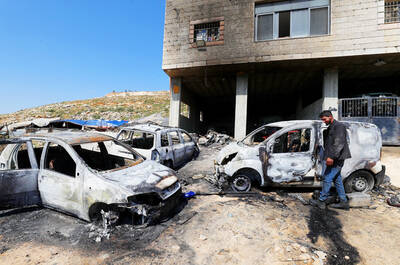A Paris court yesterday was to begin hearing a complaint brought by non-governmental organizations (NGOs) backed by 2 million citizens accusing the French state of failing to act to halt climate change.
The groups want the court to hold the state responsible for ecological damage and say victory would mark a symbolic step in the fight to persuade governments to do more.
An international accord signed in Paris five years ago aims to limit global warming to less than 2°C over pre industrial levels, and preferably to 1.5°C.
However, experts say governments are far from meeting their commitments and anger is growing among the younger generation over inaction, symbolized by the campaigns of Swedish teenager Greta Thunberg.
The French case is part of a mounting push by climate campaigners across the world to use courts against governments.
In 2019, the Dutch Supreme Court ordered the Netherlands to slash its greenhouse gas emissions by at least 25 percent from 1990 levels by the end of last year after a case brought by an NGO.
The French case began in December 2018 when four groups accused the government of failing to reduce emissions in a formal complaint backed by more than 2 million people in an online petition — a French record.
Unsatisfied with the response, the NGOs, including Greenpeace France and Oxfam France, then filed their legal complaint in March 2019 seeking symbolic damages of just 1 euro (US$1.21) from the state.
“We are full of hope for this hearing and the decision that will follow,” Greenpeace France director Jean-Francois Julliard said.
Julliard said he wanted the court to recognize that the state was not doing enough.
“The icing on the cake would be a decision to urge the state to do more to put France back on the trajectory of the Paris Agreement,” he said.
While France has committed to reducing its emissions by 40 percent by 2030 compared with 1990, the NGOs say it is exceeding the carbon budgets it pledged.
They also complain of shortcomings in the energy renovation of buildings or development of renewable energy, saying this is having a daily impact on the health and quality of life in France.
The NGOs have presented 100 testimonies from individuals with their case, after collecting more than 25,000 online.
The government rejects accusations of inaction, pointing to the energy-climate law of 2019 that “reinforces the climate goals” by aiming for carbon neutrality by 2050 or a 40 percent drop in the use of fossil fuels by 2030.
It has also rejected the request for compensatione, arguing that the state cannot be held solely responsible for climate change when France represents about 1 percent of global emissions.

Republican US lawmakers on Friday criticized US President Joe Biden’s administration after sanctioned Chinese telecoms equipment giant Huawei unveiled a laptop this week powered by an Intel artificial intelligence (AI) chip. The US placed Huawei on a trade restriction list in 2019 for contravening Iran sanctions, part of a broader effort to hobble Beijing’s technological advances. Placement on the list means the company’s suppliers have to seek a special, difficult-to-obtain license before shipping to it. One such license, issued by then-US president Donald Trump’s administration, has allowed Intel to ship central processors to Huawei for use in laptops since 2020. China hardliners

A top Vietnamese property tycoon was on Thursday sentenced to death in one of the biggest corruption cases in history, with an estimated US$27 billion in damages. A panel of three hand-picked jurors and two judges rejected all defense arguments by Truong My Lan, chair of major developer Van Thinh Phat, who was found guilty of swindling cash from Saigon Commercial Bank (SCB) over a decade. “The defendant’s actions ... eroded people’s trust in the leadership of the [Communist] Party and state,” read the verdict at the trial in Ho Chi Minh City. After the five-week trial, 85 others were also sentenced on

Conjoined twins Lori and George Schappell, who pursued separate careers, interests and relationships during lives that defied medical expectations, died this month in Pennsylvania, funeral home officials said. They were 62. The twins, listed by Guinness World Records as the oldest living conjoined twins, died on April 7 at the Hospital of the University of Pennsylvania, obituaries posted by Leibensperger Funeral Homes of Hamburg said. The cause of death was not detailed. “When we were born, the doctors didn’t think we’d make 30, but we proved them wrong,” Lori said in an interview when they turned 50, the Philadelphia Inquirer reported. The

RAMPAGE: A Palestinian man was left dead after dozens of Israeli settlers searching for a missing 14-year-old boy stormed a village in the Israeli-occupied West Bank US President Joe Biden on Friday said he expected Iran to attack Israel “sooner, rather than later” and warned Tehran not to proceed. Asked by reporters about his message to Iran, Biden simply said: “Don’t,” underscoring Washington’s commitment to defend Israel. “We are devoted to the defense of Israel. We will support Israel. We will help defend Israel and Iran will not succeed,” he said. Biden said he would not divulge secure information, but said his expectation was that an attack could come “sooner, rather than later.” Israel braced on Friday for an attack by Iran or its proxies as warnings grew of